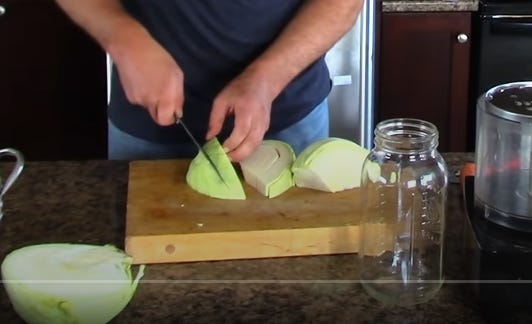Lazy Easy Fermented Cabbage
Fermented Cabbage is a versatile ingredient, but I find most recipes are either too large or needlessly complicated. Here's a quick & easy way make a single jar.
Whether it’s being used in a flavorful Asian dish, a Reuben sandwich, with bangers and mash, or on a plain old hotdog, fermented cabbage (aka sauerkraut) is a great thing to have in the fridge, and the good news is that it’s easy to make!

The price of sauerkraut, based on a quick internet search, seems to run about $5.00 or more per 500ml jar. This is amazing when one considers that the ingredients are cabbage, salt, water and time. Since the price of head of cabbage is about $3.00 at most (usually less), and since one head of cabbage makes about 1,000ml of sauerkraut, there are considerable savings to be achieved by making it, and what’s more, by fermenting
the cabbage with salt, and thus storing it in brine, it keeps for a very long time while refrigerated. When I buy a head of cabbage, I typically use one half of it right away for coleslaw, or soup, or borscht, or some other thing, but I ferment the rest in a half-gallon jar, and use it is a variety of ways. Here is how I ferment the cabbage:
Ingredients:
1/2 head of cabbage
3 tbsp pickling salt
About 1 quart of boiled water
One clean half gallon jar
Directions:
Boil the water, pour it into a jar or bowl, add the salt and stir until dissolved.
Take the cabbage, remove the heart, and the cut it into wedges (i.e. cut it into quarters, then cut the quarters in half, then cut the halves in half).
Place all of the wedges in the jar, and be sure to “jam” a good sized wedge on top, under the neck of the jar, to hold everything down (see below for explanation).
Pour the brine (water & salt) into the jar and cover
Leave jar covered with a paper bag or towel on counter (at room temperature) for one week (“burping” jar daily if necessary) then place in refrigerator.

Why this works
Cabbage begins to ferment when bacteria that are naturally in the cabbage are given their preferred environment. By providing a salty brine and keeping the light out, they get the dark, anaerobic (no oxygen) conditions they like. Thankfully, not too many other things like this environment, and as the bacteria multiply and do their thing, the acidity of the solution gradually increases to make it even less hospitable.
The final coup de grâce happens when it goes into the fridge, where the low temperature makes it even less inviting to potential pathogens. As long as all the cabbage stays submerged in the brine, and it is kept cold, it will last at least four months. By contrast, I have often found that store-bought sauerkraut rarely keeps a long time. I’m not sure why, but every time I have bought it, it needs to be used up in a few weeks or it goes moldy on top.
No “floaters” allowed
As mentioned above, the fermentation process that makes good sauerkraut depends on all of the cabbage being below the surface of the brine in the jar. There are two ways to hold everything down to ensure that this happens: (1) while packing the cabbage into the jar, reserve a couple large thick pieces to jam into the top, below the jar neck; or (2) place a sterilized inorganic weight of some kind (e.g. a stone) on top of all the cabbage, but below the surface of the water. If done correctly, and there is no vegetable matter floating or poking up above the surface, the fermentation will work perfectly.
Burping is totally ok
While the cabbage is fermenting at room temperature, gases are released from the brine. When jars are sealed tightly, the pressure builds ands the jar might explode - so the prevent this, only tighten them “finger tight”, and to be extra safe, simply loosen the lid a little bit each morning to release the pressure. This is called “burping” the jar. Alternatively, I have found that plastic mason jar lids, because they do not seal properly, are perfect for fermentation. Even when screwed on snugly, they seem to release gasses when they build up, and they also do not rust - so they are great for dealing with a salty liquid that would otherwise rust the heck out of mason jar rings. There are also fanciful valves and other cool devices that automatically release the pressure. These cost more money than simple lids, but they work and make it easier.
A very versatile ingredient
The fermented cabbage can be used in many ways. The obvious way is to take it out of the brine, squeeze out the liquid, and chop finely (lengthwise) to use as sauerkraut, but there’s other ways to use it as well. It can also be turned into coleslaw easily, by chopping it up up very finely (widthwise), and adding sugar, pepper, mayonnaise and grated carrot. Another fantastic way to use it is for Asian dishes like “Shanghai noodles”, where again, it is chopped finely (lengthwise), and tossed around with noodles, oyster sauce, sesame oil and soya sauce and whatever other ingredients are desired to have a tasty noodle dish. This may sound strange but the flavors work and it tastes great!
Final Thoughts
For many, cabbage is a humble food, unworthy of much consideration beyond that of a simple, staple food - but for me, when it is fermented, it is transformed into culinary powerhouse with it’s crunchy texture, sourness (acidity) and saltiness. It’s also the case that fermented cabbage has probiotics, so while your bourgeoise friends are paying big bucks for kefir and kombucha, you can enjoy the same health benefits while eating this simple “food of the people” on a hamburger, and be smug about how much value you’ve been able to realize from a lowly cabbage. Happy cooking!
Here’s a video where I make sauerkraut:

